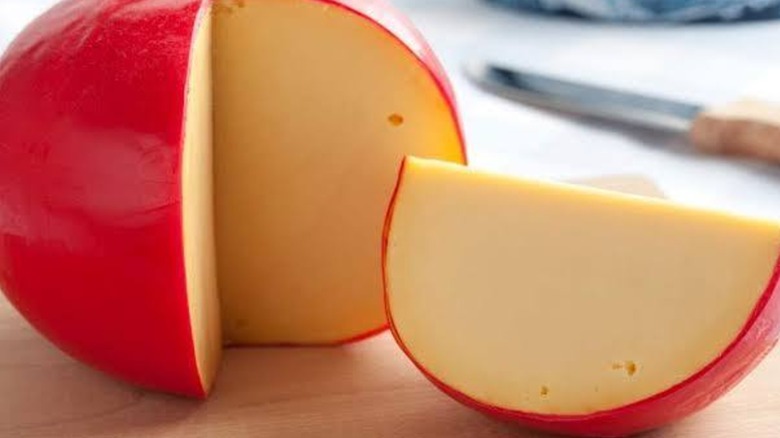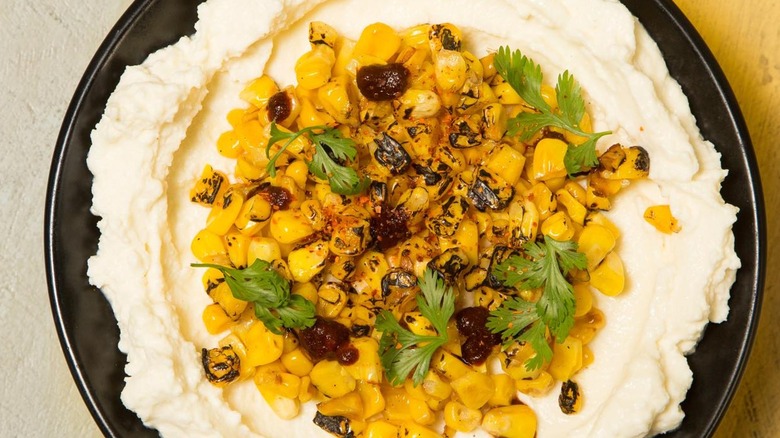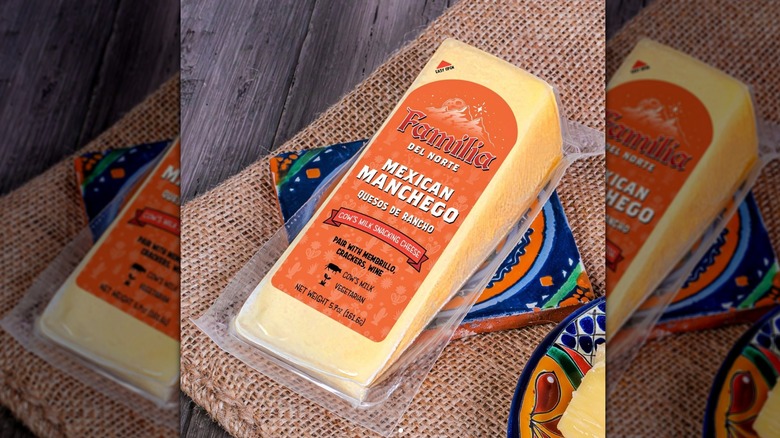12 Types Of Mexican Cheese You Should Know About
We may receive a commission on purchases made from links.
Cheese is an important part of Mexico's culinary landscape, and we're talking about far more so than the bowl of queso you're ordering at the local cantina. By some accounts, such as data from Statista, Mexico produced over 450,000 metric tons of cheese in 2024 alone. On the flip side, the country consumed nearly 650,000 (via Statista) metric tons of cheese over the same year. That spells big business for dairy farmers and queso connoisseurs alike, but an overwhelming portion of that isn't coming from the same industrialized cheese market as we see in the U.S.
There is a unique history to cheese production in Mexico, one which is primarily a legacy of colonialism. Pre-Colombian populations did not domesticate milk-producing animals like cows, sheep, or goats, so the introduction of the dairy-making process can be traced first to Spanish conquistadors, followed by other immigrant groups who settled in Mexico, such as the Mennonites. The techniques they brought with them were spread across the country. Since then, many have developed into robust, often decentralized markets and specialties of craft cheese making.
Overwhelmingly, Mexican cheeses share a profile: fresh, milky white, and mild. That said, cheeses in Mexico are specialized by region, and since they are commonly made by hand, there is a stunning amount of variation depending on where you go. If you consider yourself an explorer of cheese, Mexico's cheese traditions are some delicious ones to study.
1. Cotija
Many different types of Mexican cheeses have risen to prominence in recent decades; fewer have managed to move from the category of important culinary ingredients to cultural icons as well. Cotija has. (It helps when you're a key part of a trendy dish like Mexican street corn, also known as elotes.)
Cotija, for the uninitiated, is a type of cheese similar to parmesan but with its own standout character derived from the process of making it. It comes from the town of Cotija, Michoacán. The cheese is low in moisture and is made from cow's milk. Early in the process, the curd is broken into small bits and pressed heavily to reduce the moisture, and then, almost counterintuitively, soaked in a salt bath. The result is the richly brined flavor Cotija is known for.
You can find young Cotija cheeses — aged around three months — that feel and taste similar to feta. Cotija is considered aged once it's made it through a year of rest, and the result is some of the same depth and aroma that parmesan offers. This is one cheese that doesn't melt all that well, so it's best used as a garnish, such as finishing off huevos rancheros, or as something to mix into your roasted vegetables.
2. Oaxaca
Mozzarella lovers looking to gift their taste buds with new tastes and textures should look no further than Oaxaca cheese, eponymously named for the region it hails from. Sold around the southwestern state in braided balls, Oaxaca cheese is pressed into strips that tear into springy strings reminiscent of string cheese. However, the cow milk product is fresher than anything you'll find from a highly processed package, with a milky, salty taste and rubbery texture.
Like most queso found in Mexico, Oaxaca cheese — also called quesillo by locals — is believed to be a product of colonialism. Dominican monks who helped Spain implement their foothold in the region brought with them the process of stretching, which was modeled after the Italian process of mozzarella making. Post-colonialism, it continued to grow in popularity despite its origin and is now a proud product of the region. To make Oaxacan cheese, rennet is used to separate the cow milk curds, which are then given a hot water bath to loosen them enough for the stretching and kneading needed to create the iconic strands.
Now, you can find shreds of melted Oaxaca cheese in quesadillas and tlayudas, on tortas, empanadas, and numerous other dishes. When shopping for Oaxaca cheese, keep an eye out for the labels: Sometimes it's made with calorie-reducing skim milk, or on the flip side, made fattier by double cream.
3. Queso fresco
Being that it's most often loaded with umami, kokumi, and otherwise rich and savory profiles, cheese is rarely considered "refreshing." One style of Mexican cheese that defies that characterization is queso fresco, a "farmer's cheese" derived either solely from cow milk or a blend of goat and cow milk. Beyond its literal translation, which means fresh cheese, the light, airy texture and clean, saline flavor are what contribute to the cheese's ability to give a lift to dishes, rather than weigh them down with creamy heft.
Because queso fresco is a cheese that's easy to make, you may find it has different textures as you travel across Mexico (or your town's local Mexican restaurants). Some queso frescos will have firm, definitive curds similar to crumbled feta. Others might be looser and feel more like shaved cheese. It's also possible to try queso frescoes that are closer in feel to cottage cheese, without the liquid whey. Wherever you go, you're likely to see it broken atop enchiladas, tacos dorado con frijoles, or mole negro, where it gives a significant balance to the earthy profile.
4. Panela
The world of cheese is full of characters that melt under pressure. Add a little heat, and they go soft and oozy. In some cases, that's okay. Heck, in some cases, you want cheese that's a little weak in the knees. But other times, say, on a sandwich or crumbled up as a final touch, you want cheese that can hold its shape. Panela is the one.
Alternatively known as queso de canasta (basket cheese), panela is unaged and made from cow or sheep's milk. Curds made from the milk source are curdled with an acid. Afterward, it's squeezed to remove leftover whey and, as a result, develops into a cheese that's not incredibly high in moisture. But it isn't super dry like manchego, either. It is then pressed into a mold. Panela may come out as a wheel or a rectangle.
When cooked, panela can develop a golden-brown crust that holds form; simultaneously, it becomes soft on the inside. These characteristics make it great for pan-frying — a sort of Mexican halloumi — or for baking and spreading. It will also crumble fresh out of the container, so consider it for salads or toppings.
Panela might be easily identifiable by shape, but its origin is a bit murkier. Greece has tried to claim it as a cheese of the region, as has Italy. The Spanish likely would insist they brought it to Mexico. But panela may be a cheese that's entirely homegrown in Mexico.
5. Queso añejo enchilado
If there is one common denominator between Mexican cheeses, it's that the numerous quesos of the country are typically softer, less-aged, fresh products with milky and saline profiles. What's particularly interesting about these traits is that they run in opposition to the things most regularly associated with Mexican food, like bold flavors from aromatic ingredients and a lot of spice. Of course, most of these cheeses are ingredients that add a contrast to those swaggering plates; they aren't intended to be considered much on their own. Añejo cheese is a bit different this way.
Añejo is an aged version of queso fresco. Its maturation phase falls between two months to more than eight months, during which the skimmed cow's milk (sometimes it contains goat milk, too) will harden into a more substantial texture. But good luck slicing it: Añejo becomes firmer with age but also deepens in flavor, which is why it's so great with tacos or enchiladas.
You might see añejo cheese by another name: queso enchilado. This is a version that has been rolled around in paprika seasoning or chili powder prior to aging. The cheese will have a brilliant orangutan color and will take on some flavors from the spices. Add it over some Mexican frijoles or enfrijoladas to watch the flavors bloom.
6. Queso de Chihuahua
While the Spanish are associated with the colonization of Mexico, they are far from the only foreigners who came to the country for their own purposes. At one point, an Austro-Hungarian emperor also ruled Mexico in the name of France. The story of colonization isn't always so cut and dry as an outside force coming in of its own accord to take land from the locals. In at least one instance, a form of mass colonization came at the invitation of Mexican President Alvaro Obregón.
Sometime in the 1920s, Obregón invited populations of Mennonites into Mexico from Canada with the goal of settling land around the country. Rather than entirely taking over, these Swiss, German, and Cannuck farmers continued a practice of isolation from settlements in northern Mexican states, in turn developing a sort of cultural exchange that has gifted the world things like queso Chihuahua.
Unlike similar fresh cheeses, queso Chihuahua is a soft yellow color rather than milky white. It's also less of a crumbling cheese and better for cutting into spongey slices or melting. It's considered a young cheese with a high ability to melt due to a moisture content that can be nearly 50 percent. In particular, Chihuahua cheese has a uniquely sedgy profile that sets it apart from many other Mexican cheeses. It derives its taste from the terroir of the state, a big part of which encompasses a desert with cool, high-altitude regions adept at supporting grazing cattle.
7. Queso de bola
Queso de bola might literally translate to cheese ball, but it's pretty far off from the snack we know in America. Rather, this ball of cheese is modeled after Dutch Edam cheese. It has a red rind on the outside that protects a soft center that's the color of late summer hay fields. The taste can be just as grassy as the appearance might suggest, considering that some versions are made with raw cow's milk. (Most mass-produced renditions do not come from raw milk but are still whole milk through and through.)
Delivered by the Spanish, who traded with the Dutch through ports in the Yucatán, this form of cheese has remained immensely popular all across Mexico following the end of colonial rule and beyond. That said, it's especially popular in the Yucatán peninsula, where it is highlighted in an especially unique way: Queso relleno is a dish in which queso de bola is hollowed out and filled with any number of things, from pork picadillo to almonds, capers, and a host of spices. After filling, the cheese is poached until it is slouching, soft, and sliceable with a fork.
A visit to any grocery will show that queso de bola is a commercially produced cheese; however, artisan versions of it do exist. One example is found just south of the Yucatán, in the state of Chiapas. There, cheesemakers from the town of Ocosingo specialize in making queso de bola with small-scale, family-sized operations.
8. Queso crema
Consider a list of your favorite Tex-Mex cuisine additions or tacos Americano toppings, and it's likely that sour cream is going to cross your mind at some point. There's a clear difference between these types of foods and the cuisine that's served in Mexico — but also some similarities, such as the craving for a tangy, liquefied cream that can be poured onto pozole or mixed overtop roasted vegetables. That's queso crema.
Put simply, queso crema is Mexico's version of crème fraîche. It's slightly sour but thick, rich, and a strong finisher over any plate that needs a double dose of savory. It's more viscous than American sour cream (and not as tart) but can be used in the same applications (tacos, sauces, or even spread over some warm bread). You may see queso crema doble, which implies that the cheese is double thick (and extra fatty), so it might have similar attributes as cream cheese. The tart profile goes especially well with acidic or earthy grilled foods like poblano peppers served in tortillas, a dish called rajas con crema.
9. Requesón
Like queso de bola, queso requesón is more a Mexican version of European cheese than it is something that derives originally from the country. In this case, we're talking about Italian ricotta. Requesón shares numerous similarities with ricotta in that it's fresh, soft, grainy, and lacteal. The flavor might be slightly salty but is more so a mild and creamy tasting queso. It should not taste briny. Compared to its Italian forebear, requesón should taste a bit more acidic and will also come as a bit of a creamier texture.
When traveling through Mexico, you will likely find requesón cheese sold two ways: handmade in small batches and sold by creamerias or street and market vendors under the protection of a corn husk; or made commercially and sold in pre-packaged grocery containers. It's also one of the easiest cheeses to make yourself, given that you just need a bit of whole milk and vinegar, cooked until curds are formed and then separated by cheesecloth.
Alternatively, some sources insist that true Mexican requesón isn't just made from milk alone but actually includes the whey, called suaro, as well. Whether you choose to make it lighter by omitting the whey is your choice, but regardless, requesón is best served stuffed into a gordita or empanada or wrapped in tortilla and smothered under a hefty scoop of enchilada sauce.
10. Manchego
For a long time, the Spanish name manchego was a hot-button topic in the world of cheese. The queso has a long history in Spain, where it comes specifically from the La Mancha region and is made with the milk of Manchega sheep raised there. In fact, manchego cheese even has a denominación de origen, or a Protected Designation of Origin as per the European Union. In Spain, Manchego cheese is aged for a two-month minimum but may rest under its herringbone rind for up to two years. It's a golden, hard cheese.
Yet, Mexico has also laid its claim to a queso manchego, albeit one that is different from Spain's. First and foremost, Mexico's version is a cow's milk cheese. There isn't a minimum for maturing it, so often, Mexican manchego is softer and paler in color. Unlike other Mexican cheeses, it tastes nuttier, which is a similarity it shares with its Spanish counterpart. The origin of Mexican manchego can be traced to Spanish immigrants who settled in Puebla, south of Mexico City.
The battle over the name of this cheese is a significant issue. On the one hand, Spain has long protected the product as something that is unique to its nation; it possesses a historic and cultural value. For Mexico, manchego cheese denotes a generic process of cheesemaking that has been going on in the country since colonial days. That begs the question: If your cheese ended up on a new continent thanks to a forced and violent dispossession of land from native peoples, should they be able to keep the name of the things you brought?
11. Poro de Tabasco
Poro de Tabasco is named for its appearance, which itself is an outcome of how it is produced. The artisanal cheese hails from the Mexican state of Tabasco and is commonly made in the towns and regions of Balancán, Tenosique, Jonuta, and Emiliano Zapata. It is a fresh cheese with moderate to low moisture and a relatively firm but springy texture. It's made from cows — specifically, Zebu-Brown Swiss cows — and the milk that's used may often be unpasteurized, leading to high levels of microbial production.
Poro de Tabasco is most regularly square and always full of small holes and pores throughout. These are holdovers from the production process, which involves numerous rounds of salting, pressing, and resting, steps that create the gas that forms these pockets.
Because of its firm feel, one of the most popular uses for poro de Tabasco is in botanas de queso de puro, which means pore cheese snack. Here, the holey cheese is fried golden, covered in sauce, and served before your full meal arrives. You may also find it shredded and stuffed into tortilla rellena de mariscos, a popular seafood-focused food from the Tabasco region.
12. Asadero
The region of Chihuahua isn't just famous for its namesake queso; it is also where asadero cheese originated, as well as in the neighboring region of Sinaloa. Anecdotal history suggests that Spanish Dominican monks brought the method and recipe for creating this cheese and adapted it to the place, which would make this a centuries-old production.
Asadero cheese is very similar in texture to queso de Oaxaca. Because it is pressed, stretched, and kneaded, it has a stringy texture that makes it easy to pull apart and melt. This cheese is very salty and is best applied in chile con queso, quesadillas, or queso fundido. You can also pan-fry asadero, and it is excellent as a burger-topping cheese. Asadero may be made from raw cow milk, but more than likely, if you're purchasing it pre-packed, it is pasteurized.
Although mass-produced, there are regional variations to asadero and its production. One such example is queso asadero de la Zona Fronteriza. In this production, trompillo berries — small, regionally native nightshades — are used to curdle cow milk in place of animal rennet. This vegetable alternative turns the cheese a pale yellow color and also makes it creamier and more diverse than the brackish flavor that commercially produced asadero delivers.












